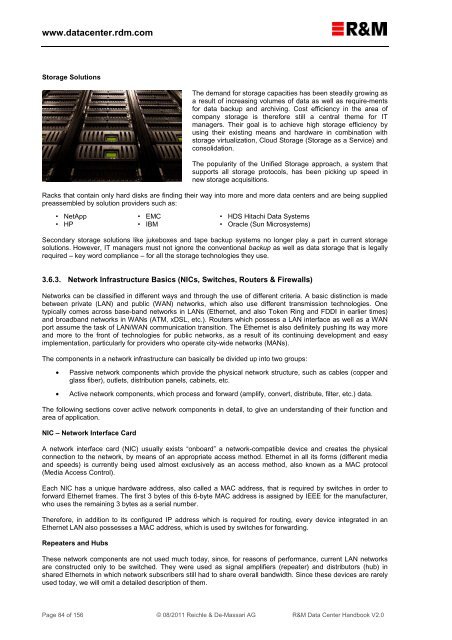R&M Data Center Handbook
R&M Data Center Handbook
R&M Data Center Handbook
You also want an ePaper? Increase the reach of your titles
YUMPU automatically turns print PDFs into web optimized ePapers that Google loves.
www.datacenter.rdm.com<br />
Storage Solutions<br />
The demand for storage capacities has been steadily growing as<br />
a result of increasing volumes of data as well as require-ments<br />
for data backup and archiving. Cost efficiency in the area of<br />
company storage is therefore still a central theme for IT<br />
managers. Their goal is to achieve high storage efficiency by<br />
using their existing means and hardware in combination with<br />
storage virtualization, Cloud Storage (Storage as a Service) and<br />
consolidation.<br />
The popularity of the Unified Storage approach, a system that<br />
supports all storage protocols, has been picking up speed in<br />
new storage acquisitions.<br />
Racks that contain only hard disks are finding their way into more and more data centers and are being supplied<br />
preassembled by solution providers such as:<br />
• NetApp • EMC • HDS Hitachi <strong>Data</strong> Systems<br />
• HP • IBM • Oracle (Sun Microsystems)<br />
Secondary storage solutions like jukeboxes and tape backup systems no longer play a part in current storage<br />
solutions. However, IT managers must not ignore the conventional backup as well as data storage that is legally<br />
required – key word compliance – for all the storage technologies they use.<br />
3.6.3. Network Infrastructure Basics (NICs, Switches, Routers & Firewalls)<br />
Networks can be classified in different ways and through the use of different criteria. A basic distinction is made<br />
between private (LAN) and public (WAN) networks, which also use different transmission technologies. One<br />
typically comes across base-band networks in LANs (Ethernet, and also Token Ring and FDDI in earlier times)<br />
and broadband networks in WANs (ATM, xDSL, etc.). Routers which possess a LAN interface as well as a WAN<br />
port assume the task of LAN/WAN communication transition. The Ethernet is also definitely pushing its way more<br />
and more to the front of technologies for public networks, as a result of its continuing development and easy<br />
implementation, particularly for providers who operate city-wide networks (MANs).<br />
The components in a network infrastructure can basically be divided up into two groups:<br />
• Passive network components which provide the physical network structure, such as cables (copper and<br />
glass fiber), outlets, distribution panels, cabinets, etc.<br />
• Active network components, which process and forward (amplify, convert, distribute, filter, etc.) data.<br />
The following sections cover active network components in detail, to give an understanding of their function and<br />
area of application.<br />
NIC – Network Interface Card<br />
A network interface card (NIC) usually exists “onboard” a network-compatible device and creates the physical<br />
connection to the network, by means of an appropriate access method. Ethernet in all its forms (different media<br />
and speeds) is currently being used almost exclusively as an access method, also known as a MAC protocol<br />
(Media Access Control).<br />
Each NIC has a unique hardware address, also called a MAC address, that is required by switches in order to<br />
forward Ethernet frames. The first 3 bytes of this 6-byte MAC address is assigned by IEEE for the manufacturer,<br />
who uses the remaining 3 bytes as a serial number.<br />
Therefore, in addition to its configured IP address which is required for routing, every device integrated in an<br />
Ethernet LAN also possesses a MAC address, which is used by switches for forwarding.<br />
Repeaters and Hubs<br />
These network components are not used much today, since, for reasons of performance, current LAN networks<br />
are constructed only to be switched. They were used as signal amplifiers (repeater) and distributors (hub) in<br />
shared Ethernets in which network subscribers still had to share overall bandwidth. Since these devices are rarely<br />
used today, we will omit a detailed description of them.<br />
Page 84 of 156 © 08/2011 Reichle & De-Massari AG R&M <strong>Data</strong> <strong>Center</strong> <strong>Handbook</strong> V2.0


